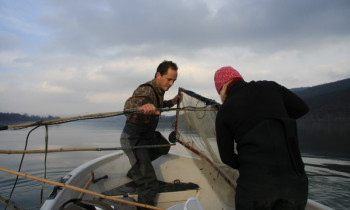The first DANUBEPARKS project concentrated on three sets of monitoring activities:
Fish are of course the most logical animals to monitor in a river ecosystem. The DANUBEPARKS Network created a fish database where data from all the protected areas was collected in a consistent format for easy comparison, so that the status of certain species can be analysed for the whole river and not just a short river stretch.
Birds are abundant in the floodplains, but a joint monitoring approach focused on two selected species because they are indicators for dynamic river systems. These are the Little-ringed Plover, breeding on gravel islands and sandbanks, and the Sand Martin, breeding in holes on steep river slopes. Both habitats only occur in naturally developing rivers shaped by the succession of floods and low waters. With the implementation of the Danube-wide monitoring in 2011, the status of river dynamics was assessed all along the river and not only in the protected areas.
Last but not least, handbooks were developed to monitor two mammal species that inhabit floodplain areas.Beavers are typical river and floodplain animals, but they occur in very different populations along the river – in theAustrian Donau-Auen they are abundant, whereas in the Hungarian Danube protected areas they are close to extinct. Our Slovak partners put together a Beaver Manual, and the Hungarian partners did a study on the reintroduction of beavers. The European mink was once a typical inhabitant of the Lower Danube areas, but now is critically endangered. The Danube-Delta Biosphere Reserve Authority therefore produced a handbook for European mink monitoring and protection measures.
As mentioned above, monitoring species and habitats for these areas is an important part of Natura 2000 management. The Danube Delta produced a Natura 2000 handbook, based on bilateral discussions and study visits, to coordinate the monitoring and protection approach regarding the Natura 2000 species, habitats and tasks for the future of the entire Danube River.

